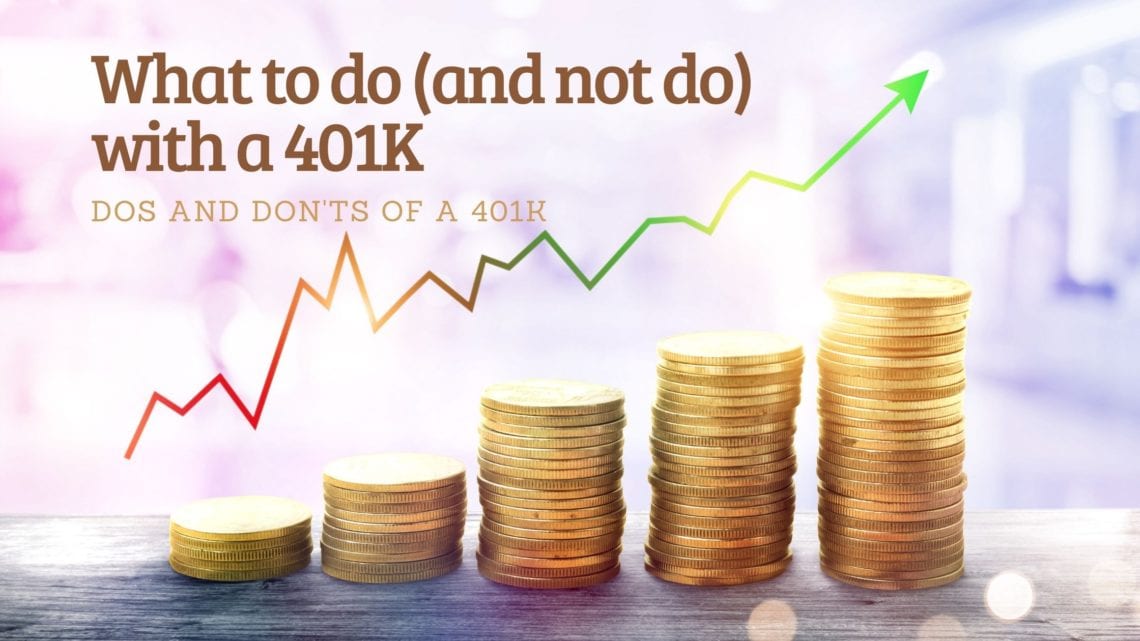
7 Rules for Your 401K
As an Amazon Associate I earn from qualifying purchases. We may earn money or products from other companies mentioned in this post at no cost to you!
Reading Time: 6 minutesHave you ever made a financial mistake?
That’s a rhetorical question, we’ve all done it, ha ha! I wanted to write a “dos and don’ts” guide for 401K’s specifically because that’s an area in which I personally have some of my biggest financial regrets.
This post is geared more towards younger individuals who are just starting in their careers, but anyone who wants to get serious about their retirement accounts could find value in this. This article will focus on 401K’s but you could apply this to other types of retirement accounts, as well.
DO: Start!
This is probably the most important piece of advice you could get when it comes to retirement planning.
It may seem very basic and obvious, but so many fail to even start that I feel like I can’t skip this piece of advice.
I can include myself in this category. It took me a couple of years into my career job to take advantage of all the benefits I was eligible for. The best thing one can do is simply to start contributing to your retirement right away.
If you’re struggling to start contributing because your paycheck is naturally going to be smaller (which is true, it’s called savings), consider that your tax payments will also not be as big.
When you’re investing in a 401K, that means your contribution is based on your gross salary, so before taxes are taken out, or “pre-tax”. This contribution actually lowers the amount you’re taxed on, so you don’t have as much in taxes being taken out of your paycheck.
If your workplace doesn’t offer retirement benefits, you can deposit funds to a traditional IRA or Roth IRA outside of your workplace. So, basically, there’s no excuse to not start!
DON’T: Leave money on the table.
What I mean by this is when you don’t contribute enough to get your full matching contribution from your employer. I include this advice because I know enough people who were either not contributing at all, or they didn’t want to contribute as high as 6% to get their full company match.
If you don’t know what “the match” is, it’s when your company says they’ll “mach” half up to 6%, meaning you contribute 6% and they’ll contribute 3%, as an example. That means, in total, you’ll have 9% of your salary going into your retirement every paycheck! It’s like when you start a new job and they give your offer letter with your new salary, but then offer an extra 3% on top of that… only catch is that you have to save 6% of your own money for your own retirement in order to get that. Why would you take less?
Let me show you an example of what it will really cost you to have your contributions as high as you need to for the full match. Let’s say you’re starting out at $40K/annually and you’re paid bi-weekly. That’s $1,538 before tax on your paycheck. If you contribute 3%, that’s $46 of your paycheck. If you contribute 5%, that’s $76. Trust me, I think you can spare the extra $30 (pre-tax) per paycheck.
Always, always, always contribute the full amount so you can maximize the match you’re receiving.
DO: Invest!
Okay, you’ve started contributing, that’s great! But now what?
Your employer will not (and really, cannot) take care of your money for you. Don’t just let your money sit there, you need to tell it what to do.
Workplace retirement plans will have some sort investment options for you within that plan. You need to tell your contributions where you want them to go so you can start increasing your money.
The concept of increasing your money through investments is known as the “power of compounding”. The funds that you’re invested in will have growth, capital gains, and dividends. All of these increase your wealth over time without you having to do anything but contributing a part of your paycheck.
Read this article from Capital Group to get a better understanding with examples of what compounding is and how valuable it will be for you. Do your research, invest your money, and put your money to work for you.
DON’T: Blindly invest!
Now that I’ve told you to invest, let me insert a caveat, ha ha! Although I’m not going to get too in depth with the investing part in this post, I will say that you need to put in the work on this to get it done right.
I strongly suggest talking to a financial advisor at least once to help understand how you should invest your money within your 401K. You should still also do your own research on the options offered, find out what all the terms that you don’t understand actually mean so you know for yourself what you’re investing in. If you don’t, you might end up in a low earning CD or fund.
This is my cautionary tale because this is what happened to me when I first started my retirement. I picked an investment strategy out of the five offered, and I really just picked one that I thought looked good. It was something like a 80% stock and 20% bonds mix, not even close to what I would do now that I’m more informed.
Worse yet, I sent in the paperwork, my employer didn’t process it, and I didn’t realize it for months! Not only had I picked a mediocre investment strategy to begin with, the company put me in their default fund that was basically just as good as a CD. CD’s, by the way, barely keep up with inflation, so this was not good for me. It took me so long to figure out what had happened because I didn’t know what I was looking at when I would look at my retirement account online.
Once I realized that I wasn’t in stocks at all, I just went to a financial advisor one time to help me allocate my funds. My knowledge increased so much from just that one visit, and I ended up getting into a customized 100% stock investment strategy.
Learn a lesson from me: get educated enough so you know what you’re looking at in your online account, and talk to someone who can actually help you.
DO: Increase your contributions over time.
If you’re contributing enough to get your full match, that’s good! That may be 3%-6%, and kudos to you for even starting to save! But could you save more?
Try increasing your contributions by even just small amounts. You could increase your savings rate 1% at least annually, if you don’t want to do it more often or a higher savings rate. If you’re making $50,000 a year, an extra 1% per year is $19 spread out over 26 paychecks. I think you can do it.
You want to try to get up to 15%-20% of your income being saved in retirement, as a general rule of thumb. Doesn’t necessarily need to be in your 401K (and there is a limit) but doesn’t hurt to use your easiest retirement vehicle.
Usually you can schedule these increases from your retirement plan. If you can time this with a raise, you won’t even notice the extra contributions.
DON’T: Under any circumstances, withdraw your money from your retirement!
Not only will you get taxed at the normal tax rate on the money you pull out, you will also pay a 10% penalty!
You also need to consider that taking a lump sum on top of your regular salary could put you in a higher tax bracket, so your “normal” tax rate may actually be higher than it would otherwise be! So, you would be paying a 10% penalty and possibly be paying a higher rate of tax on that money than if you had just taken it in a paycheck in the first place.
You may hear around your work place, and possibly even have it suggested by financial experts or human resource rep, that you can withdraw your 401K money for things like purchasing a home, or you can take a loan from your 401K and pay yourself back with interest. DO NOT DO THIS! This is terrible advice. This isn’t an emergency fund, or your fund that you’re using to save for a down payment on a home.
See my post about separating your savings for different purposes, like saving for a home.
Retirement accounts are for retirement. This is for your future self, don’t rob him.
DO: Consider a Roth, if given the option.
While contributing to a regular 401K can be an advantage to you by lowering your tax liability, you should also consider a Roth 401K, which does not.
Roth 401K’s function the same as a Roth IRA in that they are funded with your money after taxes have come out of your paycheck (“post-tax”). This can kind of sting because it is dollar-for-dollar reducing your paycheck.
However, Roth accounts have the advantage of its earnings being withdrawn (at reitrement age) with no taxes due on the gains! If your time horizon is long, like several decades, this is definitely an advantage.
So while you’re paying tax now and reducing your paycheck in order to fund your Roth, the future tax savings could be much more than the tax savings now.
If your employer offers a Roth option (and if you’re not sure, ask), ask a financial advisor or accountant about what to do. They’ll give you different scenarios and ultimately leave it up to you to decide.
Closing
I hope the main takeaway here is to start contributing to your retirement account as soon as possible. Get a little educated about your investment choices (they’re limited within a 401K plan anyway), and don’t take it out early!
RELATED
See the beginner’s guide to 401K’s
See “5 Foolproof Steps for Early Retirement” by Tyler at Fresh Life Advice that incorporates some of these concepts into a plan for early retirement.
IF YOU WANT TO SEE MORE…
Consider subscribing to my e-mail list. You can always unsubscribe, I won’t spam you!
Follow me on Facebook, Instagram, or Twitter.
Save this post on Pinterest by using the share buttons, and follow me, too!
If you want to start a blogging business, check out this FREE course!
If you want to make money from a blog, check out this program that got me started making my own money blogging!






5 Comments
FreshLifeAdvice
Thank you for the shout out Ashley! You really broke down an intimating topic like the 401k into layman’s terms. Since we are both early in our careers, it’s imperative to be invested more so in stocks than bonds. There is an old rule of thumbs that says you should take 100 and subtract your age. The result is the percentage of your assets to allocate to stocks (also referred to as equities). However, you and I can agree we have more risk tolerance.
Thank you for sharing your story about the mistake of your company putting you invested into their default fund. It’s anecdotes like these that will save many young professionals from making similar blunders.
cinayet süsü izle
Wonderful blog! I found it while browsing on Yahoo News. Van Onfre Slavic
bollywood
You actually make it seem so easy with your presentation but I find this matter to be really something which I think I would never understand. It seems too complex and extremely broad for me. I am looking forward for your next post, I will try to get the hang of it! Darleen Granny Ader
1080p
Great post! We are linking to this great content on our website. Keep up the good writing. Natalee Tudor Countess
netflix
Thanks for the various tips contributed on this blog site. Marena Tristam Orson